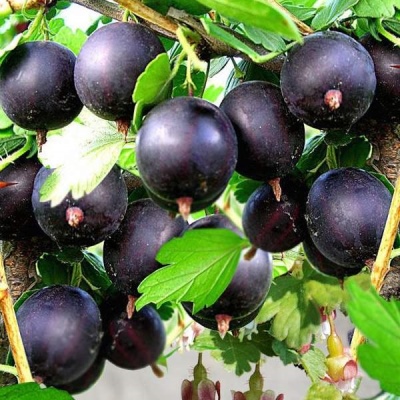
- Growth type: medium-sized
- Description of the bush: moderately sprawling
- Berry size: large enough
- Berry weight, g: 3,5
- Berry shape: oval
- Berry color: black, waxy
- Skin : thin, not pubescent
- Taste: sweet and sour, with a slight black currant flavor
- Appointment: universal
- Winter hardiness: high
All berry crops, including gooseberries, include a huge number and variety of varieties. They differ in many characteristics, such as berry color, taste, yield, cultivation techniques, and so on. The African variety can be called a completely exotic representative of the culture. And he fell in love with gardeners not only because of its unusual appearance, but also due to its unpretentiousness, lack of thorns, and good health.
Breeding history
The African variety has been known for a long time; it originates in the 1970s. The culture was bred by domestic breeders on the basis of the Saratov Horticultural Experimental Station. However, the variety is not included in the State Register, which does not prevent it from growing practically throughout the country.
Description of the variety
The plant is distinguished by its medium height, moderate spreading of the shrub. In height, the bush reaches, as a rule, 1-1.2 meters, but sometimes it grows up to 130 cm. The thorns are infrequent and small, sometimes they are absent at all.
Gooseberry African has many advantages. These include:
- high productivity;
- excellent presentation of fruits;
- pleasant taste;
- easy care;
- versatility of application;
- transportability;
- high content of vitamins and minerals.
Of the minuses, only the susceptibility of culture to anthracnose is noted.
Characteristics of berries
The oval-shaped berries are of medium size. Their weight varies from 2.5 to 4 g. The color of the fruit is from dark red to almost black. There is a waxy bloom on the berries.
Taste qualities
The gooseberry has a very tender and juicy pulp. Sweet and sour berries are somewhat reminiscent of black currant in taste.
Ripening and fruiting
African is a crop of mid-early ripening of berries. If you provide the plant with proper care, its active fruiting will begin already in the second or third year of development.
Yield
The gooseberry of the described variety is distinguished by rather high yield rates, in some cases an indicator of up to 12 kilograms per bush is recorded.
Landing
It is possible to plant seedlings of the described plant in a permanent place both in the spring and in the fall. Experts recommend giving preference to planting carried out in the autumn months. The main thing is to do this in advance, a few weeks before the cold snap, the first frost. At this time, the root system grows better. The spring period is considered less favorable for disembarkation. The fact is that the buds bloom quite early, and planting at the wrong time can lead to plant disease and even a decrease in yield.
For planting a crop, you should choose an area on an elevation that will be well illuminated by the sun. Groundwater should flow no closer than one and a half meters from the surface. Soils are suitable loamy or sandy loam. It is also important to protect the bushes from drafts and cold air currents.
When choosing seedlings, it is worth giving preference to one- or two-year-olds, which already have a well-formed root system. The main thing is to make a purchase in nurseries with a good reputation. Before the planting procedure, the roots should be soaked in a special solution that stimulates their growth.

Growing and care
The gooseberry of the variety in question does not tolerate waterlogged soil very well. Therefore, it is important to carry out special measures for the care of the soil. So, in the spring, immediately after the snow melts, it is necessary to loosen the soil under the bush very well, this will help to ensure the flow of oxygen to the root system. Subsequently, this procedure (loosening) will need to be carried out as needed, but at least 4 times during the growing season.
Each gooseberry bush is watered with a volume of liquid in 1-2 buckets. It is important to ensure that the water does not stagnate.
The surface of the ground around the bushes is covered with mulch - a 7-8 cm layer is enough. So the soil will not dry out, and the weeds will not grow.



Disease and pest resistance
Gooseberry has good immunity, it is immune to diseases such as powdery mildew, as well as other fungal ailments. However, for prophylaxis, it is recommended to treat plants with Bordeaux liquid - a 3% solution, in the period before bud break, as well as a 1% solution of the same agent before flowering. Experts believe that this will help prevent shrub diseases.

In order for the gooseberry to produce a good harvest, it is necessary to devote time to disease prevention.
Resistance to adverse climatic conditions
An important distinguishing feature of the variety is its resistance to both high and low temperatures. For example, during periods of drought, it will be enough to pour a large volume of water under the bush; this should be done 2-3 times during the season. Cold resistance is expressed by the flowering of the culture, which is possible even at temperatures in the air up to +10 degrees, and in winter, the branches are able to withstand frosts down to -30 degrees Celsius.




































































